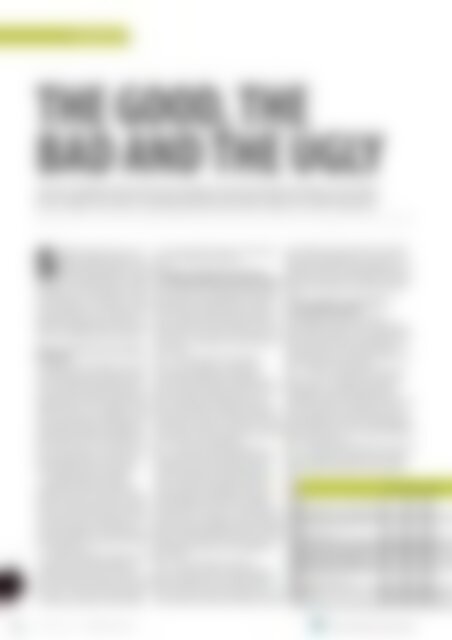201509 CM September
THE CICM JOURNAL FOR CONSUMER AND COMMERCIAL CREDIT PROFESSIONALS
THE CICM JOURNAL FOR CONSUMER AND COMMERCIAL CREDIT PROFESSIONALS
Create successful ePaper yourself
Turn your PDF publications into a flip-book with our unique Google optimized e-Paper software.
INSOLVENCY<br />
THE GOOD, THE<br />
BAD AND THE UGLY<br />
Jeremy Sutcliffe poses three key questions around personal insolvency and offers<br />
some insight into what is working presently and what might be a better approach.<br />
STALWART readers will know how<br />
regularly and passionately I have<br />
covered personal insolvency, during<br />
20 years commentating on judicial<br />
statistics in Credit Management. I make no<br />
apologies for continuing to draw attention<br />
to this important – but neglected – credit<br />
industry component. This time I am posing<br />
three questions key to the industry, and<br />
offering some answers and insight, in an<br />
attempt to highlight what’s not working at<br />
present, and suggest a better approach.<br />
What is the overall cost of personal<br />
insolvency?<br />
The figure isn’t in the public arena. Each<br />
individual bankruptcy estate concludes<br />
with a financial account submitted to the<br />
Insolvency Service (the Agency) by the<br />
licence-holding insolvency practitioner (IP)<br />
responsible for it, which creditors of that<br />
estate can scrutinise. The Agency thus has<br />
all the information at its fingertips, but it’s<br />
not generally available. It’s possible the<br />
figure has been deliberately supressed to<br />
avoid creditor shock, but inefficiency is<br />
the more likely reason. I doubt the Agency<br />
has ever got to grips with the overall<br />
financial statistics, which its position of<br />
responsibility should have dictated.<br />
As regards individual voluntary<br />
arrangements (IVAs), the information<br />
resides with the IPs and their insolvency<br />
firms involved in the procedure. A register<br />
of IVAs is maintained by the Insolvency<br />
Practitioners Unit in Birmingham, available<br />
to the public as part of the Individual<br />
Insolvency Register on the Agency website,<br />
but this doesn’t include either individual or<br />
overall cost figures.<br />
In neither case does the Agency provide<br />
any general cost information/advice to<br />
creditors, because IPs and their firms –<br />
who remain its main point of contact, rather<br />
than the creditors and debtors who pay for<br />
insolvency – have been continually able<br />
to persuade the Agency that publication<br />
would breach IPs rights of confidentiality,<br />
and commercial information.<br />
Why is regulated work effectively<br />
limited to estates with excess assets?<br />
I’m referring to excess unsecured assets,<br />
naturally, since by definition secured ones<br />
belong to the charge holders. If there’s<br />
nothing in the kitty, the choice facing an IP,<br />
or in default the Official Receiver (OR), is<br />
threefold (1) ask the creditors to stump up<br />
for the work, (2) pay for it personally, or (3)<br />
not do it, and the first two are mostly nonstarters.<br />
Since the ‘rebirth’ of insolvency<br />
in the mid-eighties, money owed to<br />
unsecured creditors has fuelled an<br />
extensive programme of regulated work<br />
on bankruptcy estates. While it’s essential<br />
to produce a basic financial account<br />
for each estate, regulated work is more<br />
comprehensive, and creditors offered the<br />
choice of whether to take what’s left in the<br />
estate as a dividend, or ‘donate’ it to the IP<br />
for further work/investigation would be very<br />
unlikely to choose the latter!<br />
Historically, creditors tended not to<br />
become aware of the distinction between<br />
estates with excess assets and those<br />
without, because the latter languished<br />
out of sight and mind under the control<br />
of the OR. Since 2009 the inception of<br />
Debt Relief Orders (DROs) has brought<br />
the dichotomy clearly to their attention,<br />
albeit DROs involve no work, regulated or<br />
otherwise in looking after creditor interests,<br />
and are rather designed to protect debtors<br />
from creditor collection activity up to a debt<br />
limit of £15,000 (imminently increasing to<br />
£20,000), rather than to investigate their<br />
estates!<br />
The vast majority of personal<br />
insolvencies contain nothing suspicious<br />
or controversial, so why should creditors<br />
not be able to influence the amount of<br />
work done, beyond a necessary minimum?<br />
I accept that Turkeys are unlikely to vote for<br />
Christmas, but since IPs have not sought<br />
to reduce regulated work, why isn’t the<br />
Agency putting this idea forward? The only<br />
type of reform currently being offered by<br />
IPs is better ways for creditors to complain<br />
about the quality of work actually done!<br />
Who should be responsible for<br />
personal insolvency?<br />
The Agency is part of a business<br />
department that has little contiguity with<br />
insolvent individuals, and the methodology<br />
for dealing with them is essentially a cutdown<br />
version of corporate insolvency.<br />
Personal insolvency would fit better within<br />
the Ministry of Justice (MoJ).<br />
In the past 10 years there have been<br />
just over 1,176,000 personal insolvency<br />
procedures, consisting of bankruptcy<br />
petitions, IVAs and debt relief orders<br />
(DROs). Bankruptcy petitions have reduced<br />
considerably over the decade, but IVAs<br />
actually reached an all-time high last year,<br />
and together with DROs - both designed to<br />
avoid insolvency – they totalled 574,000, 47<br />
percent of the total.<br />
The Agency has recently announced that<br />
future debtor bankruptcies will no longer<br />
require sign off from an IP, which means<br />
that a further proportion of cases have no<br />
INSOLVENCY CREDITORS<br />
BANKRUPTCY PETITIONS<br />
DEBTORS BANKRUPTCY<br />
PETITIONS<br />
WINDING-UP PETITIONS<br />
DEBT RELIEF ORDERS<br />
INDIVIDUAL VOLUNTARY<br />
ARRANGEMENTS<br />
TOTAL<br />
2005 2006 2007<br />
20,777 20,891 20,055<br />
36,897 52,678 53,106<br />
12,099 12,108 11,676<br />
_ _ _<br />
20,293 43,630 42,723<br />
90,066 129,307 127,560<br />
<br />
<br />
36 <strong>September</strong> 2015 www.cicm.com<br />
The recognised standard in credit management


















